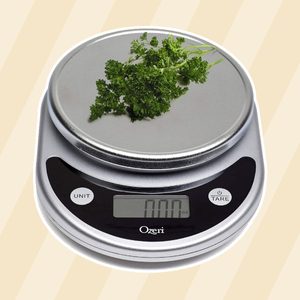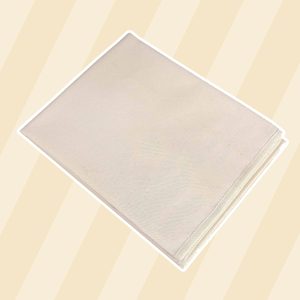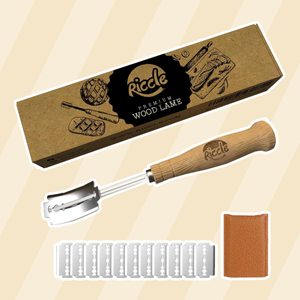How to Make a Baguette
Updated: Feb. 12, 2024
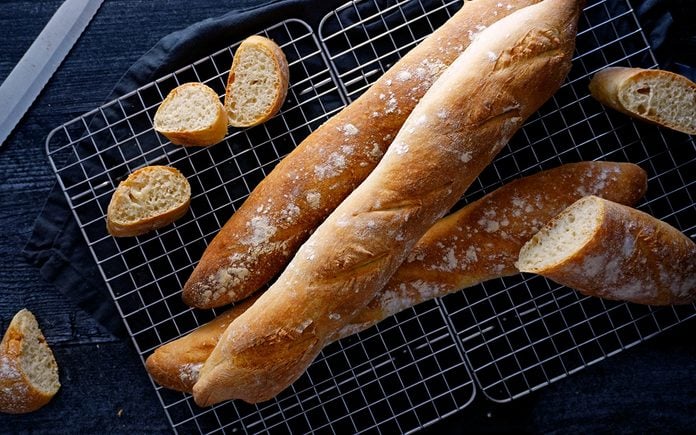
This guide will teach you how to make baguettes that look magnifique—like they belong in a French boulangerie.
You know you’ve made it as a home bread baker when you make your first batch of perfectly golden, crusty baguettes. While these iconic French loaves are among the most basic of bread recipes, learning how to make a baguette is no small feat. Careful measurement, precise proofing and specific shaping and scoring techniques are all essential to create perfect French baguettes.
It may take you a few tries, but with a little practice and the tips and tricks in this baguette recipe, you can learn to bake up baguettes worthy of a handshake from Paul Hollywood.
On This Page
What Is a Baguette?
A baguette is a long, wand-shaped loaf of French bread named for its shape and made with a basic, lean bread dough as defined by French law.
Dough
We’re not kidding! The French love their bread and put the French Bread Law of 1993 (Décret Pain) in place to protect the quality and authenticity of bread sold in boulangeries throughout the country. According to the law, true baguettes can only be made with four ingredients (wheat flour, water, salt and yeast) and should be free of additives or preservatives.
Texture
A baguette’s dough composition is what gives the bread its famous crusty exterior and overall chewiness. Because there is no oil or fat in the dough, a baguette must rely solely on its water content for moisture. During baking, the water in the dough morphs into steam, making the insides soft. As the baguettes bake, the steam evaporates from the dough’s surface, leaving behind a dry, firm crust.
Shape
The shape of a baguette also sets it apart from other loaves. Traditionally, baguettes are 2 to 2-1/2 inches in diameter and usually a little over 2 feet in length. Formed by hand, baguettes should have a tapered shape with a wider middle that narrows to a point at either end. Slashed with a sharp knife or razor blade, authentic baguettes are scored along their length at a strong diagonal. The bread scoring is important here because it helps control the expansion of the loaf as it bakes, in addition to giving the loaves an appealing appearance.
How to Make a French Baguette
Yield: Makes four 12-inch baguettes
Ingredients
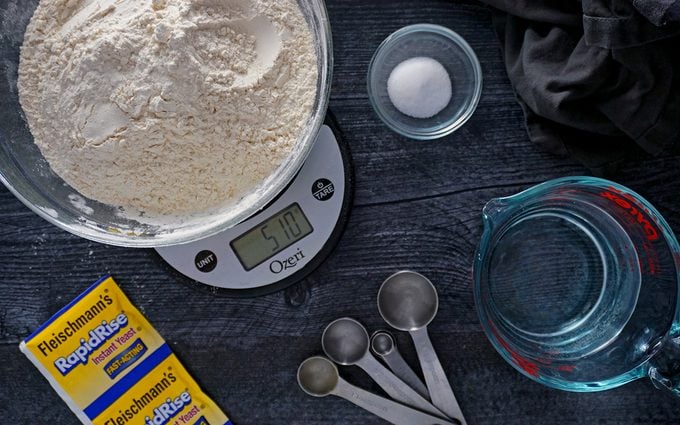
- 4-1/4 cups (510g) bread flour
- 2 teaspoons (10g) salt
- 2-1/2 teaspoons (10g) instant yeast
- 1-1/2 cups (375ml) warm water, heated to 105-110°F
- 1 tablespoon olive oil, for greasing a proofing container
Tools for Making Baguettes
While none of these items are 100-percent necessary to make baguettes, they will each contribute immensely to the outcome of your final baked product.
- Food Scale: We’ve said it before and will say it again: Your baking will improve tremendously once you start measuring your ingredients by weight using a simple food scale. It’s more accurate than measuring by volume.
- Digital Thermometer: The temperature of your water matters. Too cold and you won’t activate your yeast. Too hot and you’ll kill it. Pick up a digital food thermometer to ensure your water is at the proper temperature for optimal yeast activation.
- Stand Mixer: You can, of course, mix and knead bread dough by hand for a nice workout. But a stand mixer will save you time and energy when baking baguettes.
- Square Proofing Container: This one may surprise you, but proofing your dough during its first rise in a 2- to 4-quart plastic container will help you shape your dough into baguettes with ease.
- Baking Couche: You’ll feel super official using a baking couche when proofing baguette. When pleated between your unbaked loaves, this heavy linen cloth will help them retain their shape during their second proof.
- Sharp Knife or Razor: A sharp knife is a must for getting perfect cuts when you’re scoring. If you want to be really fancy, pick up a bread lame—it’s what master bakers use for scoring artisan bread loaves.
- Baking Stone: Baguettes bake beautifully on baking stones because they recreate the atmosphere of commercial ovens. Baking stones help absorb the oven’s heat and transfer it more evenly to your baguette than traditional sheet pans.
Directions
Step 1: Measure precisely
Carefully measure your dry ingredients and add them to the bowl of a stand mixer fitted with a hook attachment. For best results, we recommend using a food scale to accurately measure your ingredients by weight.
Test Kitchen tip: Don’t put your salt directly on top of the yeast. Add them to separate sides of the bowl and allow them to combine once you start mixing the dough in the next step. It sounds silly but it will help your yeast activate properly.
Step 2: Add water
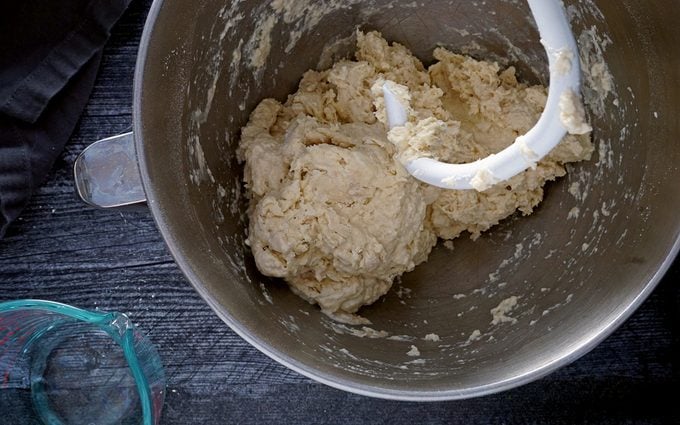
Add the warm water to the dry ingredients and begin mixing on your mixer’s lowest speed for 1 to 2 minutes. Once the dough begins to come together, increase to your mixer’s second speed and knead the dough for 6 to 8 minutes. The dough is ready once it is smooth, elastic and cleanly pulls away from the sides of the bowl.
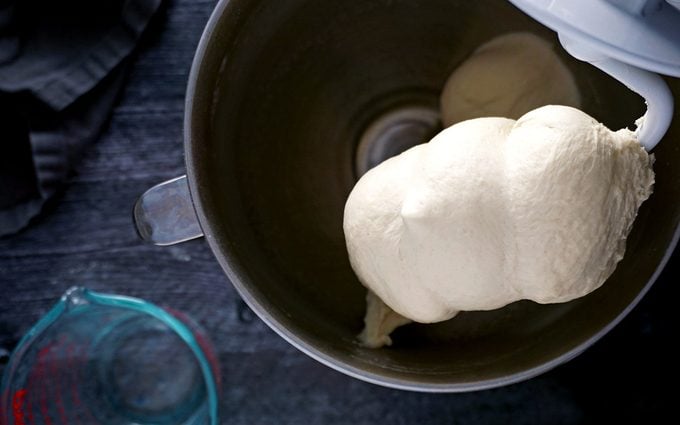
Step 3: First rise
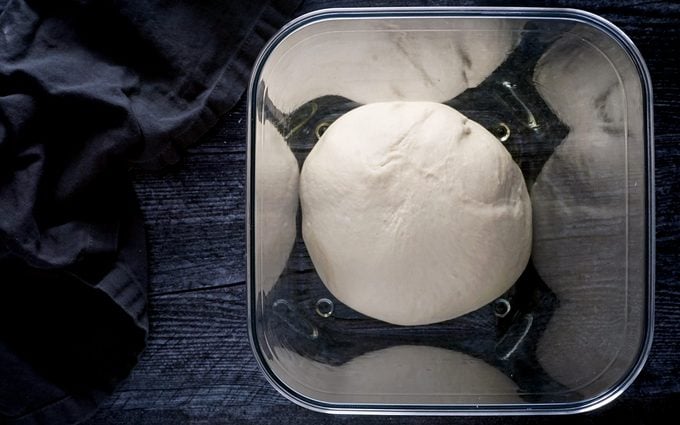
While the dough mixes, oil a large, square plastic container (2 to 4 quarts) with 1 tablespoon of olive oil. Add the dough to the container and cover with plastic. Let rise in a warm, draft-free place for 1 hour until doubled in size. If your oven has a “proof” setting, feel free to use it.
Baking in winter? This is how to proof bread when it’s cold out.
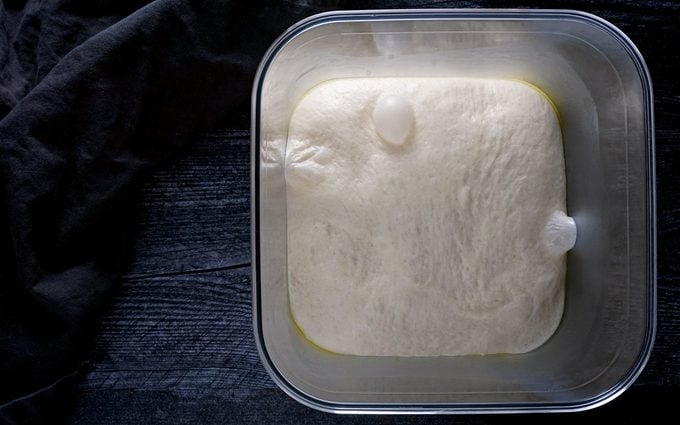
Step 4: Divide the dough
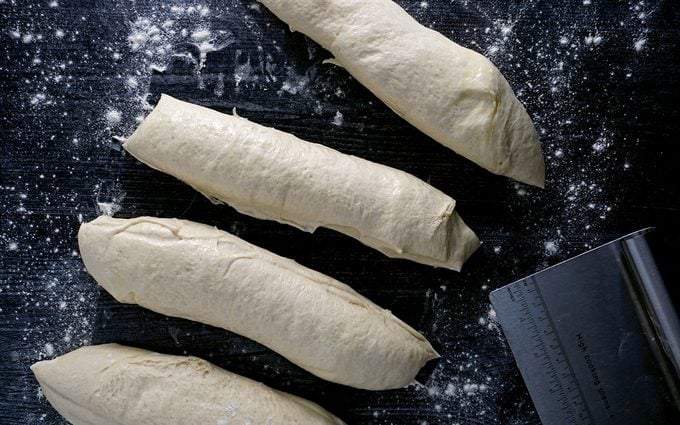
Meanwhile, dust a work surface with flour and position a lightly dusted baking couche (or large linen tea towel) beside your main work area. Carefully tip the risen dough out onto your work surface and divide the dough, using a bench scraper. You want four equally sized oblong pieces of dough.
Test Kitchen tip: Don’t punch the dough down. Instead, handle with care. This will keep as much air as possible in the dough so your final loaves have that perfect open-crumb structure.
Step 5: Shape
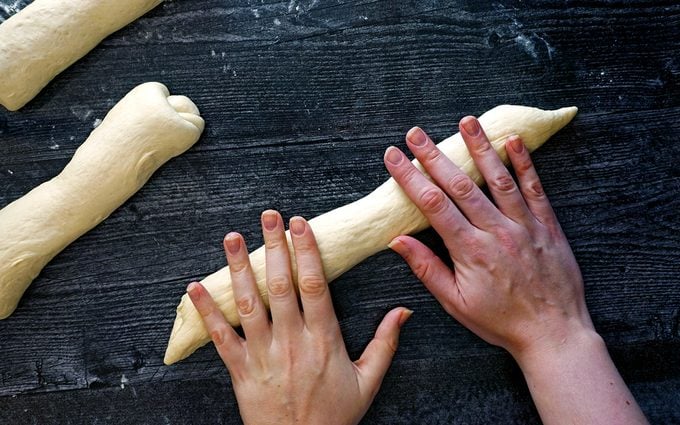
Next, carefully stretch each of the four dough pieces gently with your fingers, so they’re about 8 inches long and 4 inches wide. Fold the longer ends of the dough toward the center, sealing the seam with the flat of your hand. Repeat on both the top and bottom edges to make a sausage-shaped envelope. Let the dough rest for 5 to 10 minutes covered with a damp towel.
After a quick rest, take one of the “envelopes” and begin to gently shape and roll out the dough to a 12- to 16-inch-long rod using your hands. The baguette should have a smooth top and be a bit fatter in the center with tapered points at either end. Repeat for the remaining three baguettes.
Step 6: Second rise
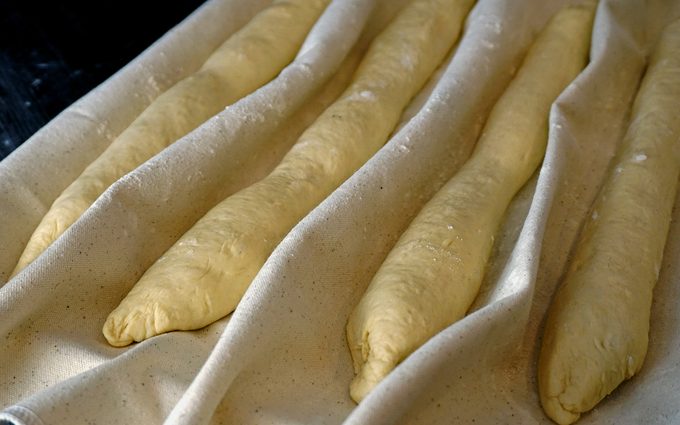
Transfer one baguette to the edge of your prepared baking couche. Pleat the couche so a ridge of fabric rests alongside the baguette. Place another baguette on the other side of the pleated ridge and repeat until all four baguettes are lined up on the couche.
Cover loosely with the excess of your baking couche and proof for 1 hour in a warm, draft free place until doubled in size. The baguettes are ready when the dough springs back quickly when pressed gently with your finger.
Step 7: Prep the oven
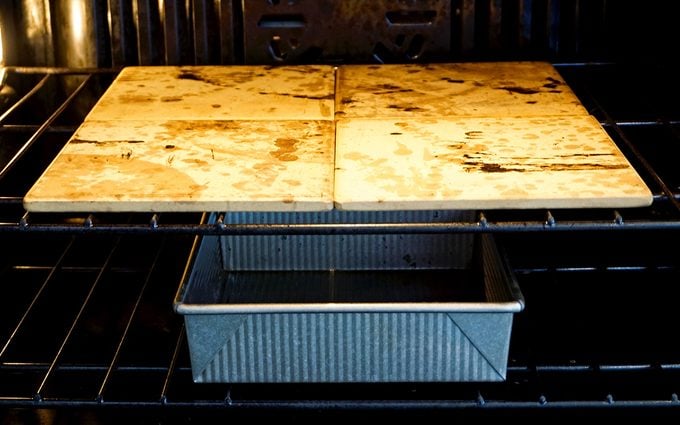
With your oven rack in the middle position, add a large baking stone to the cold oven. Place a shallow roasting pan under the oven rack and begin to preheat your oven to 475°F.
If you don’t own a baking stone, simply bake the baguettes on a parchment-lined baking sheet. Choose a high-quality baking sheet designed to transfer heat evenly.
Step 8: Score
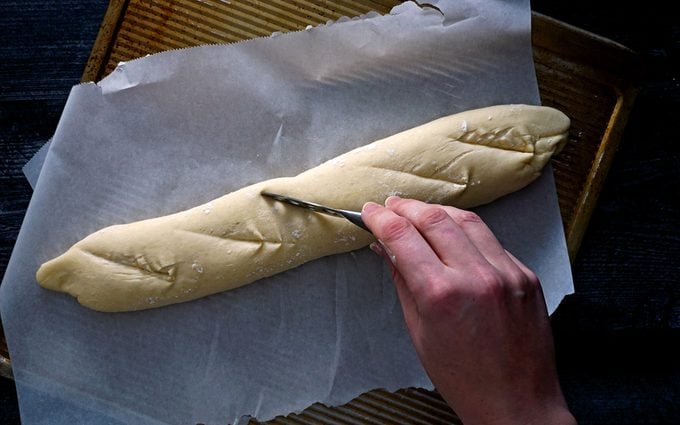
When the baguettes have fully risen, transfer them from the couche to a baking sheet lined with parchment paper. For best results, tip the baguettes from the couche to the baking sheets rather than lifting them with your hands, which can cause them to deflate. Then use a sharp knife or razor blade greased with olive oil to score the tops of each baguette 4 to 5 times.
Test Kitchen tip: When scoring baguettes, make your cuts quickly to avoid a jagged incision. Each cut should be about 1/4-inch deep down the middle of the baguette at a 45-degree angle.
Step 9: Bake
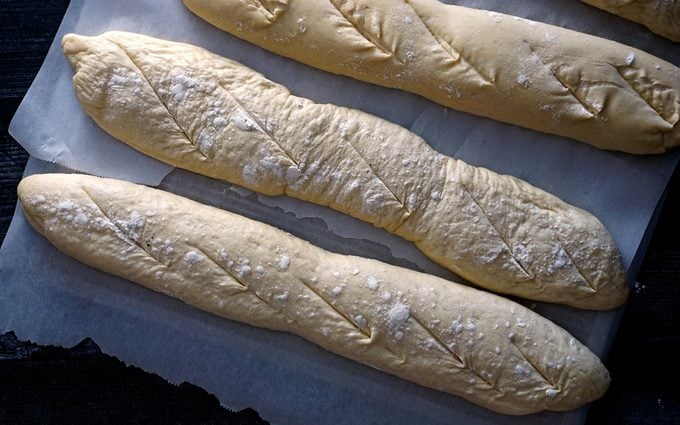
Transfer the baguettes to the preheated oven, carefully sliding the baguettes and parchment onto the hot baking stone. Next, quickly fill the roasting tray with water to create steam and close the oven door. Bake for 20 to 25 minutes, or until the baguettes are deep golden brown and sound hollow when tapped gently with a finger. Cool on a wire rack.
Test Kitchen tip: Don’t skip the steam. The steam is what helps baguettes develop their crispy, chewy crust!
How to Use a Baguette
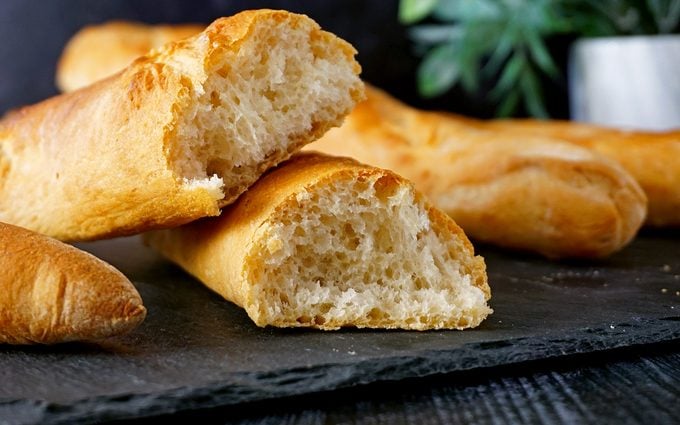
In France, baguettes are traditionally served plain without any type of butter, jam or spread to accompany them, though there are some regions where baguettes are eaten with salted butter. School children will enjoy them cut in half and spread with a generous amount of Nutella.
In your own kitchen, however, feel free to enjoy your homemade baguettes as you please. Top them with jam, or turn them into a hearty submarine sandwich or bahn mi. If your baguettes dry out before you can enjoy them, don’t throw them away. Cut into cubes and make homemade croutons or grind them into homemade breadcrumbs.
Recipes That Pair Well with Baguettes
Baguettes are also delicious paired with recipes where they can function as a vessel for scooping up dip or sopping up broth and sauce. Here are a few of our favorites:
How to Store a Baguette
Stored properly, a baguette will remain fresh for two days. However, baguettes are always best eaten within 24 hours, especially if they have been sliced open. A baguette’s firm crust protects the bread’s interior from drying out once removed from the oven, so it’s best to store baguettes unsliced to help them stay fresh longer.
Keep your baguetteat room temperature in paper bags or a bread box rather than plastic. Paper bags and bread boxes allow any excess moisture to escape, so the baguette’s exterior remains crusty.
Can a Stale Baguette Be Revived?
To breathe life back into a baguette that’s starting to becoming a little stale, brush it with water, wrap it tightly in foil and then place it into your oven (do not preheat). Set your oven to 300° and warm your baguette for 10 to 15 minutes.

